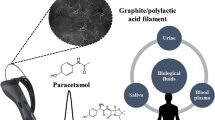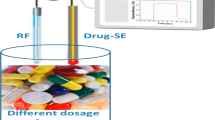Abstract
The major objective of this work was to develop a portable, disposable, cost-effective, and reliable POC solid-state electrochemical sensor based on potentiometric transduction to detect benzodiazepine abuse, mainly diazepam (DZP), in biological fluids. To achieve that, microfabricated Cu electrodes on a printed circuit board modified with the conducting polymer poly(3-octylthiophene) (POT) have been employed as a substrate. This polymer was introduced to enhance the stability of the potential drift (0.9 mV/h) and improve the limit of detection (0.126 nmol mL−1). Nernstian potentiometric response was achieved for DZP over the concentration range 1.0 × 10−2 to 5.0 × 10−7 mol L−1 with a slope of 55.0 ± 0.4 mV/decade and E0 ~ 478.9 ± 0.9. Intrinsic merits of the proposed sensor include rapid response time (11 ± 2 s) and long life time (3 months). In order to enhance the selectivity of the potentiometric sensor towards the target drug and minimize any false positive results, calix[4]arene (CX4) was impregnated as an ionophore within the PVC plastic ion-sensing membrane. The performance of the POC sensors was assessed using electrochemical methods of analysis and electrochemical impedance spectroscopy as a surface characterization tool. The studied sensors were applied to the potentiometric determination of DZP in different biological fluids (plasma, urine, saliva, and human milk) in the presence of its metabolite with an average recovery of 100.9 ± 1.3%, 99.4 ± 1.0%, 101.8 ± 1.2%, and 99.0 ± 2.0%, respectively.





Similar content being viewed by others
References
Organization WH (2018) World drug report, management of substance abuse. World Health Organization
Moeller MR, Kraemer T (2002) Drugs of abuse monitoring in blood for control of driving under the influence of drugs. Ther Drug Monit 24(2):210–221
Gray TR, Shakleya DM, Huestis MA (2009) A liquid chromatography tandem mass spectrometry method for the simultaneous quantification of 20 drugs of abuse and metabolites in human meconium. Anal Bioanal Chem 393(8):1977
Lager P, Attema-de Jonge M, Gorzeman M, Kerkvliet L, Franssen E (2018) Clinical value of drugs of abuse point of care testing in an emergency department setting. Toxicol Rep 5:12–17
Attema-de Jonge ME, Peeters SY, Franssen EJ (2012) Performance of three point-of-care urinalysis test devices for drugs of abuse and therapeutic drugs applied in the emergency department. The Journal of Emergency Medicine 42(6):682–691
Tang RH, Liu LN, Zhang SF, He XC, Li XJ, Xu F, Ni YH, Li F (2019) A review on advances in methods for modification of paper supports for use in point-of-care testing. Microchim Acta 186(8):521
Draz MS, Moazeni M, Venkataramani M, Lakshminarayanan H, Saygili E, Lakshminaraasimulu NK, Kochehbyoki KM, Kanakasabapathy MK, Shabahang S, Vasan A (2018) Hybrid paper–plastic microchip for flexible and high-performance point-of-care diagnostics. Adv Funct Mater 28(26):1707161
Schmitz A (2016) Benzodiazepine use, misuse, and abuse: a review. Mental Health Clinician 6(3):120–126
Keim SA, McNamara K, Kwiek JJ, Geraghty SR (2015) Drugs of abuse in human milk purchased via the internet. Breastfeed Med 10(9):416–418
El-Rahman MKA, Zaazaa HE, ElDin NB, Moustafa AA (2015) Novel strategy for online monitoring of the degradation kinetics of propantheline bromide via a calixarene-based ion-selective electrode. Talanta 132:52–58
Abd El-Rahman MK, Rezk MR, Mahmoud AM, Elghobashy MR (2015) Design of a stable solid-contact ion-selective electrode based on polyaniline nanoparticles as ion-to-electron transducer for application in process analytical technology as a real-time analyzer. Sensors Actuators B 208:14–21
Elzanfaly ES, Hassan SA, Salem MY, El-Zeany BA (2016) In-line potentiometric monitoring of dissolution behavior of verapamil hydrochloride versus traditional pharmacopeial method: a comparative study. Sensors Actuators B Chem 228:587–594. https://doi.org/10.1016/j.snb.2016.01.040
Sanghavi BJ, Wolfbeis OS, Hirsch T, Swami NS (2015) Nanomaterial-based electrochemical sensing of neurological drugs and neurotransmitters. Microchim Acta 182(1–2):1–41
Ruppert C, Phogat N, Laufer S, Kohl M, Deigner H-P (2019) A smartphone readout system for gold nanoparticle-based lateral flow assays: application to monitoring of digoxigenin. Microchim Acta 186(2):119
Mousavi MP, Abd El-Rahman MK, Mahmoud AM, Abdelsalam RM, Bühlmann P (2018) In situ sensing of the neurotransmitter acetylcholine in a dynamic range of 1 nM to 1 mM. ACS sensors 3(12):2581–2589
Abd El-Rahman MK, Zaazaa HE, ElDin NB, Moustafa AA (2016) Just-dip-it (potentiometric ion-selective electrode): an innovative way of greening analytical chemistry. ACS Sustain Chem Eng 4(6):3122–3132
Lindner E, Buck RP (2000) Microfabricated potentiometric electrodes and their in vivo applications. Anal Chem 72(9):336 A–345 A. https://doi.org/10.1021/ac002805v
Bakker E, Pretsch E (2007) Modern potentiometry. Angew Chem Int Ed 46(30):5660–5668
El-Rahman MKA, Al-Alamein AMA, Abdel-Moety EM, Fawaz EM (2017) Integrated gold-thiol based potentiometric sensors for in situ dual drug-protein binding studies on naproxen/diphenhydramine salts model. J Electrochem Soc 164(14):H1013–H1020
Zdrachek E, Bakker E (2018) Electrochemically switchable polymeric membrane ion-selective electrodes. Anal Chem 90(12):7591–7599
Bobacka J (1999) Potential stability of all-solid-state ion-selective electrodes using conducting polymers as ion-to-electron transducers. Anal Chem 71(21):4932–4937
Järvinen H, Lahtinen L, Näsman J, Hormi O, Tammi A-L (1995) A new method to prepare 3-octylthiophene and poly-(3-octylthiophene). Synth Met 69(1–3):299–300
Sutter J, Radu A, Peper S, Bakker E, Pretsch E (2004) Solid-contact polymeric membrane electrodes with detection limits in the subnanomolar range. Anal Chim Acta 523(1):53–59
Chen Z-L, Hibbert D (1997) Simultaneous amperometric and potentiometric detection of sugars, polyols and carboxylic acids in flow systems using copper wire electrodes. J Chromatogr A 766(1–2):27–33
Pei X, Kang W, Yue W, Bange A, Heineman WR, Papautsky I (2014) Disposable copper-based electrochemical sensor for anodic stripping voltammetry. Anal Chem 86(10):4893–4900
Kang W, Pei X, Bange A, Haynes EN, Heineman WR, Papautsky I (2014) Copper-based electrochemical sensor with palladium electrode for cathodic stripping voltammetry of manganese. Anal Chem 86(24):12070–12077
Jafari Y, Ghoreishi SM, Shabani-Nooshabadi M (2016) Polyaniline/graphene nanocomposite coatings on copper: electropolymerization, characterization, and evaluation of corrosion protection performance. Synth Met 217:220–230. https://doi.org/10.1016/j.synthmet.2016.04.001
Fenelon AM, Breslin CB (2002) The electrochemical synthesis of polypyrrole at a copper electrode: corrosion protection properties. Electrochim Acta 47(28):4467–4476. https://doi.org/10.1016/S0013-4686(02)00518-2
Tüken T, Yazıcı B, Erbil M (2005) Polypyrrole/polythiophene coating for copper protection. Progress in Organic Coatings 53(1):38–45. https://doi.org/10.1016/j.porgcoat.2004.11.008
La Belle JT, Gerlach JQ, Svarovsky S, Joshi L (2007) Label-free impedimetric detection of glycan−lectin interactions. Anal Chem 79(18):6959–6964
Rubinova N, Chumbimuni-Torres K, Bakker E (2007) Solid-contact potentiometric polymer membrane microelectrodes for the detection of silver ions at the femtomole level. Sensors Actuators B Chem 121(1):135–141
Bühlmann P, Pretsch E, Bakker E (1998) Carrier-based ion-selective electrodes and bulk optodes. 2. Ionophores for potentiometric and optical sensors. Chem Rev 98(4):1593–1688. https://doi.org/10.1021/cr970113+
Bühlmann P, Chen LD (2012) Ion-selective electrodes with ionophore-doped sensing membranes. Supramolecular Chemistry: From Molecules to Nanomaterials
Buck RP, Lindner E (1994) Recommendations for nomenclature of ionselective electrodes (IUPAC) recommendations 1994. Pure Appl Chem 66(12):2527–2536
Commission BP, Britain G (2010) British pharmacopoeia 2011. Stationery Office,
Peeling RW, Holmes KK, Mabey D, Ronald A (2006) Rapid tests for sexually transmitted infections (STIs): the way forward. Sex Transm Infect 82(suppl 5):v1–v6
Author information
Authors and Affiliations
Corresponding author
Ethics declarations
The whole study was approved and supervised under the Ethics Committee of Faculty of Pharmacy, Cairo University. All human biological fluids samples were obtained from the Holding Company of Biological Products and Vaccines, VACSERA (Giza, Egypt) with permission.
Conflict of interest
The authors declare that they have no competing interests.
Additional information
Publisher’s note
Springer Nature remains neutral with regard to jurisdictional claims in published maps and institutional affiliations.
Electronic supplementary material
ESM 1
(DOCX 1.20 mb)
Rights and permissions
About this article
Cite this article
Hassan, S.A., ElDin, N.B., Zaazaa, H.E. et al. Point-of-care diagnostics for drugs of abuse in biological fluids: application of a microfabricated disposable copper potentiometric sensor. Microchim Acta 187, 491 (2020). https://doi.org/10.1007/s00604-020-04445-x
Received:
Accepted:
Published:
DOI: https://doi.org/10.1007/s00604-020-04445-x




